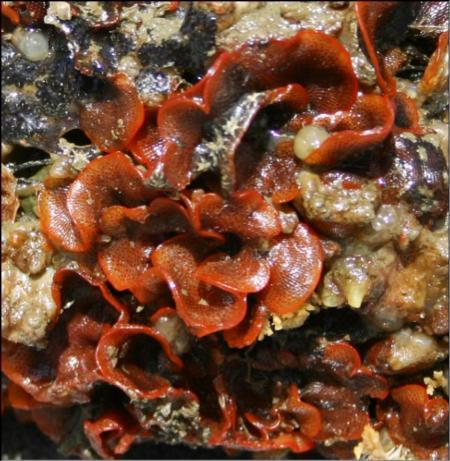Encrusting Bryozoan
-
Scientific Name
Watersipora subtorquata - Visit ITIS for full scientific classification.
-
Description
 Watersipora subtorquata. Photo by Carrie Culver © 2008 Regents, University of California.
Watersipora subtorquata. Photo by Carrie Culver © 2008 Regents, University of California.- Colonial invertebrate animals.
- This bryozoan species forms a brittle structure containing individual animals inside.
- Encrusts hard surfaces.
- Bright orange-red to black in color.
- It develops overlapping crusts, or petals, that can grow into large masses, up 24 inches long and 12 inches high.
- Each crust or petal is comprised of small, closely packed “houses” where the individual animals in the colony live.
- The individual animals in the colony are called zooids, and appear as small, black dots to the naked eye.
- When viewed under a microscope, the soft-bodied animals (zooids) with their translucent feeding tentacles become visible.
-
Habitat
- Common in lower intertidal, and subtidal areas.
- More abundant in areas with higher water flow.
- Found on a wide variety of natural and man-made surfaces including: rocks, shells, vegetation, woody debris, other marine animals, pier pilings, vessel hulls, oil platforms, etc.
-
Invasion Pathways and Distribution
- Spread by attaching to vessel hulls, from which larvae swim to settle on surfaces in marinas.
- Found worldwide, including California.
- Origin unknown, but non-native to North America.
- See NEMESIS for a distribution map.
-
Life History
- Filter-feeder.
- Reproduce sexually by releasing sperm and eggs into the water, where they unite to form swimming larvae.
- The larvae settle onto hard surfaces and develop into zooids.
- The mature zooids asexually bud into a colony capable of sexual reproduction, producing new larvae.
-
Impacts
- The encrusting leaf-like bryozoan structure can form large masses on boat hulls, piers and other structures.
- This fouling growth roughens the hull’s surface, creating friction or “drag” that slows sailboats and increases fuel consumption for powerboats.
- Tolerant of copper in antifouling paint.
- It also provides non-toxic surfaces for other fouling species to settle and develop.
- Competes for space with native species.
-
References and Useful Links
For references by category and links to other useful AIS sites see our LEARN MORE page.

